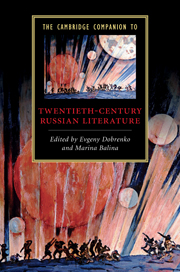Book contents
- Frontmatter
- 1 Poetry of the Silver Age
- 2 Prose between Symbolism and Realism
- 3 Poetry of the Revolution
- 4 Prose of the Revolution
- 5 Utopia and the Novel after the Revolution
- 6 Socialist Realism
- 7 Poetry after 1930
- 8 Russian Epic Novels of the Soviet Period
- 9 Prose after Stalin
- 10 Post-Soviet Literature between Realism and Postmodernism
- 11 Exile and Russian Literature
- 12 Drama and Theatre
- 13 Literature and Film
- 14 Literary Policies and Institutions
- 15 Russian Critical Theory
- Index
13 - Literature and Film
Published online by Cambridge University Press: 28 May 2011
- Frontmatter
- 1 Poetry of the Silver Age
- 2 Prose between Symbolism and Realism
- 3 Poetry of the Revolution
- 4 Prose of the Revolution
- 5 Utopia and the Novel after the Revolution
- 6 Socialist Realism
- 7 Poetry after 1930
- 8 Russian Epic Novels of the Soviet Period
- 9 Prose after Stalin
- 10 Post-Soviet Literature between Realism and Postmodernism
- 11 Exile and Russian Literature
- 12 Drama and Theatre
- 13 Literature and Film
- 14 Literary Policies and Institutions
- 15 Russian Critical Theory
- Index
Summary
The story of film in Russia begins on 4 May 1896 in St Petersburg, with a showing by the Lumière Brothers of their ‘cinematograph’, just over four months after they had first exhibited it to paying customers in Paris. The earliest Russian films were newsreels, the first of them footage shot by a French cameraman nine days later of celebrations to mark the coronation of Nicholas II. For over a decade the cinematic diet offered to Russian audiences consisted of foreign fiction films and Russian newsreels, but by 1907 early Russian entrepreneurs were anxious to make fictional films from Russian subjects. Since a new Russian art form had to be invented, these pioneers naturally turned to the existing arts for inspiration, to theatre, painting, and photography for the visual resolution of their works, to literature, theatre, and song for their initially minimal narratives. In 1907 Alexander Drankov shot a version (now lost) of scenes from Pushkin’s tragedy Boris Godunov. A year later his studio produced Stenka Razin, directed by Vladimir Romashkov. Released on 15 October 1908, and now conventionally known as the first Russian film, it was based upon a popular song about the rebel hero, which audiences were encouraged to sing while watching it. Thus literary sources gave film-makers their plots and gave audiences stories with which they were already familiar. In 1909 Petr Chardynin filmed Chekhov’s story ‘Surgery’ (Khirurgiia) and then turned to Gogol’s Dead Souls (Mertvye dushi). His approach to a work of this length was to stage and film two episodes from the novel, in which Chichikov visits Sobakevich and Pliushkin.
- Type
- Chapter
- Information
- The Cambridge Companion to Twentieth-Century Russian Literature , pp. 235 - 250Publisher: Cambridge University PressPrint publication year: 2011

